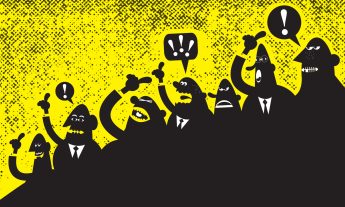
British psychologist Elizabeth Stokoe studies the patterns in talk that most of us don’t even notice. She explains how her research can be used to train people to interact more effectively.
People spend a good deal of time talking to one another, and in general we do it pretty well. We might feel excited, angry, embarrassed, or — if we’re lucky — loved, in the course of our daily conversations. So is there any benefit to thinking about a science of talk? Can we really gain anything from scientific analysis of something we “just do”?
I believe we can, and I’ve spent the last 20 years studying real talk from real people talking to each other in real time. And while the linguist Noam Chomsky once described conversation as a “disorderly phenomenon,” I can tell you that it’s no such thing. Conversation is highly systematic and organized … and it tells us an incredible amount about the power of language to shape our daily lives.
Take this ordinary telephone call between two friends, Nancy and Hyla, transcribed according to the standard conversation analysis transcription system, which includes intonation and the actual sounds being made rather than just the correct spelling of a word (lines under a word represent emphasis and different movements in pitch, the equals sign means that the turns are very rapid):

On the face of it, this is utterly mundane. There’s no science here! Well, actually there is. Conversation analysts have shown that, across settings including phone calls, face-to-face encounters, Skype calls and even instant messaging, conversations routinely contain three component pairs of actions: summons and answer (the opening — lines 1-2); greetings and identification (for Hyla and Nancy, just the sound of the voice is enough for identification — lines 3-4), and initial enquiries (the ‘how-are-yous’ at lines 5-6).
Perhaps this seems obvious. But now let’s take a look at the start of a call between boyfriend and girlfriend, Dana and Gordon.

Like Nancy, Gordon produces an answering “hello.” But rather than being met with a greeting, there is instead a gap of seven-tenths of a second. For conversation analysts, that’s enough of a delay to indicate trouble. Hyla and Nancy spoke rapidly, with a tenth of a second or less between their turns. In this instance, even though only one word has been uttered, we already know enough to expect that Dana and Gordon are unlikely to proceed smoothly through the next two pairs of conversational components. Here’s what Dana says next:

Dana returns the greeting, but rather than move into the “how-are-yous” portion of the conversation, she asks Gordon a question. It’s not an innocent question; it is antagonistic. As Gordon’s girlfriend, she implies that she’s entitled to know where he’s been “all morning”; she’s been trying to get him “all morning.”
That we can pinpoint moments of trouble so precisely has big pay-offs when it comes to understanding professional or workplace encounters. For example, we can search for silences and work out had happened previously to produce it. In my work with organizations from the police force to commercial sales teams, I’ve been able to show practitioners which words and phrases are most effective — and what does not work. Here’s a look at some of my more recent findings, as well as a great study by a pair of American conversation analysts.
1. Are you willing?
I’ve worked with mediation services that help people in a dispute with their neighbor, partner or colleague. By analyzing hundreds of calls between mediators and their potential clients, it became clear that some callers don’t really want mediation; they want a lawyer, police officer or housing company to arrest, evict or otherwise constrain the other party’s behavior. They have been referred to mediation as a last resort, and many callers reject it on the basis that the other party is the “kind of person who won’t mediate.” Without knowing how to overcome that hurdle, the call is over and the client is lost. However, I found that when mediators asked people if they would be “willing” to mediate, even resistant callers agreed to try the service. “Willing” was significantly more effective than other phrasing such as “might you be interested in mediation?” — and it was the only word that achieved a total turnaround from “no” to “yes.” My theory: it works because if the other party is the kind of person who won’t mediate, then the caller must be the kind of person who will…!
2. How did you hear about us?
When people telephone companies to buy things — in the case of my research, new windows and doors — the call is mostly about what the caller wants. But the company often wants something too — to know how the caller heard about them. After all, they’re invariably spending money on advertising, so what advertising space is worth buying? Some salespeople ask, “how did you hear about us?” at the start of the call. Others wait until the end of the call to ask, “just before you go, would you mind telling me where you heard about us?” Both questions deliver a request for information, but the first one is often followed by a long silence, which we know indicates trouble. The second one is followed by an immediate answer that indicates there was no trouble in asking it. Being careful about the placement and wording of requests can have an impact on the rapport between caller and salesperson; knowing what works can enable companies to optimize their calls.
3. Why were you arrested?
Police officers are trained to ask a certain type of question when they talk to arrested suspects. Training manuals recommend open-ended questions that don’t push for any particular information: “Tell me about your day from when you woke up this morning to the point that we met.” However, it turns out that a more specific format is far more effective in eliciting the sorts of accounts that police actually want from suspects. The question “can you tell me the circumstances in which you were arrested?” had better results than the training manual question, which could prompt people to describe what they had for breakfast! This is because, unlike the open-ended question, it focuses the narrative. Why is the more effective question not in the manual? Because this guidance is based on theory, not evidence. Much communication guidance is the same, which means people are often trained to do the wrong thing.
4. Any or some?
American conversation analysts John Heritage and Jeffrey Robinson examined the impact when doctors changed just one word in a question: “any” to “some.” The issue: Patients were frequently leaving appointments without voicing all of their concerns, resulting in dissatisfaction and inefficiencies. One reason might be that doctors’ opening questions, such as “What can I do for you today?”, typically elicit only one concern. Recognizing this problem, medical school training recommends that, after discussing the initial problem, doctors then ask, “is there anything else we need to take care of today?” However, analysts have shown that questions containing the word “any” typically receive negative responses. In Heritage and Robinson’s experiment, one group of doctors asked the “any” question; another used the word “some”: “Is there something else we need to take care of today?” That small change showed a statistically significant uplift in reported concerns. The finding tells us some other interesting things. First, while not every “some” works, outcomes cannot simply be attributed to style, personality or gender. Second, as with the examples above, it suggests what language should appear in communication training.
I developed a technique called CARM (the Conversation Analytic Role-play Method) to help people assess conversations and understand what a difference a word can make. What I love about conversation analysis is that often insights are just under our nose, waiting for close inspection to suggest a smarter way to communicate. As we saw in the “willing” case, the effective practice was right there all along.
Featured image courtesy iStock.











